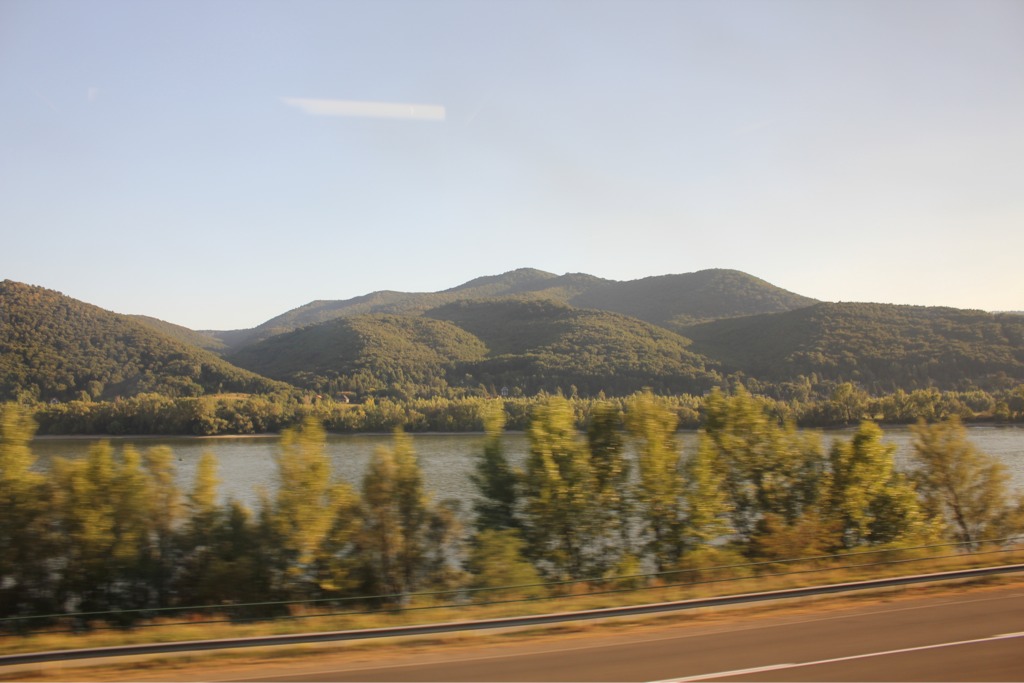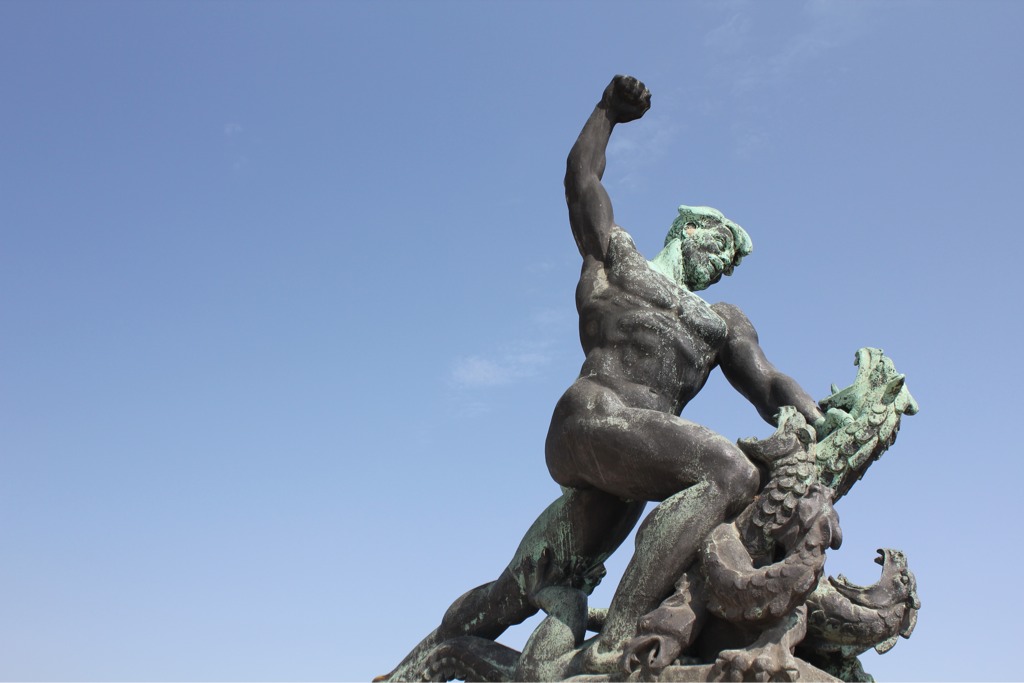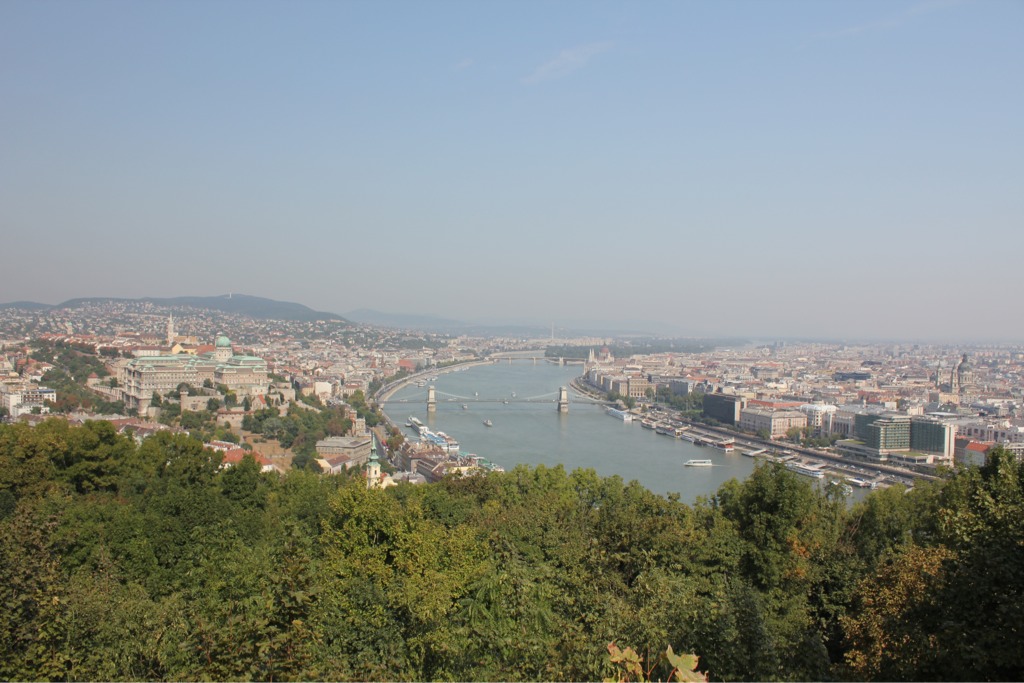 Given that our last post made comment on expectations, it's worth noting that, aside from a certain dessert, we didn't really have a specific idea what we'd find upon arriving in Budapest. Again, we'd heard a few things (it's beautiful, full of history, the Danube), but it all had melded together into a blur of excited conversations and dreaminess. Why did we go? Sort of two reasons, beyond the general curiosity to go anywhere. First, those of you who've been following from the beginning might remember that we worked and became friends with a Hungarian couple in Scotland who, having grown up in small towns in Hungary, shared enough stories and thoughts (and food) to pique our curiosity. Second, it provided a good starting place for our train journey to Istanbul. We were so close, coming from Prague, so we couldn't, in good conscience, let it be missed.
Given that our last post made comment on expectations, it's worth noting that, aside from a certain dessert, we didn't really have a specific idea what we'd find upon arriving in Budapest. Again, we'd heard a few things (it's beautiful, full of history, the Danube), but it all had melded together into a blur of excited conversations and dreaminess. Why did we go? Sort of two reasons, beyond the general curiosity to go anywhere. First, those of you who've been following from the beginning might remember that we worked and became friends with a Hungarian couple in Scotland who, having grown up in small towns in Hungary, shared enough stories and thoughts (and food) to pique our curiosity. Second, it provided a good starting place for our train journey to Istanbul. We were so close, coming from Prague, so we couldn't, in good conscience, let it be missed.

The train ride from Prague gave us three hours to slowly, quietly become acquainted with the Hungarian landscape. The Danube glimpsed through trees, lush hillsides blurring by, rolling into Keleti International Train Station with excitement for more newness. We found a
guesthouse in a relatively central part of Pest, walkable from our arrival point, with a kitchen, and run by the absolute sweetest woman - for the same cost as two dorm beds in a hostel. Definitely worth it. After unloading our bags and decompressing our bodies, we hightailed it to the supermarket nearby to do our usual sweep of investigations, get some groceries and, most importantly, find some Türörudi. This is one of the three words we knew coming into Hungary. The others were bograč: a cauldron for gulash, and köszönöm: thank you.
Turorudi, the aforementioned dessert, is essentially cannoli filling (sweetened cottage cheese, though), scented with orange, and covered in dark chocolate. It comes in log form, slightly smaller than a candy bar. The *best* one (white package with red dots, goes by the name of Pöttyös...) is found in the diary aisle, refrigerated. (Thanks, M!) We devoured ours right on the sidewalk outside of the store, like greedy children. It was worth every wild-eyed second. A delicious introduction to Budapest.
We were very lucky to have beautiful weather to explore Budapest in. A metro ride up to the Parliament area dropped us off next to the Danube north of the gargantuan building, where we witnessed brave souls running a half marathon. As we walked towards our destination, we ended up near the finish line (having followed the music and cheering), and joined a group of supporters in hooting and hollering. There was a band set up playing what seemed to be electronic gypsy folk: including an electronic wind instrument and kids with impeccable beat timing joining in, which was absolutely awesome. Listen closely HERE, as the music is a little buried under the crowd noise. Spy the Parliament building in the background and the Danube creeping in on the right, here:

The Ethnographic Museum, or
Néprajze Múzeum, was something that had made it onto our to-do list thanks in part to its current temporary exhibit on hand woven rugs and textiles, but the museum itself was equally fascinating, providing a glimpse into the life and culture of rural Hungary over the past couple hundred years; details, examples and videos on everything from hat making to wedding ceremonies to food production.
We explored our way through the Great Market Hall, or Nagycsarnok, which is far more popular with the tourist set, and another few, more local, markets in the Pest neighborhoods. Having caught the smaller ones at odd times or near closing, the Grand Market was worth walking through. We watched foreigners gawk, old ladies haggle, and shopkeepers entice. Strings of peppers, tins of paprika, jars of pickled everything, ungodly amounts of salami and keilbasa all crowded our landscape in the most orderly way. Everything was quite clearly divided, albeit a bit claustrophobic within itself, which simply built on our giddiness for more markets to come:

Our hike up and over
Gellért Hill, on the Buda side of this endlessly and subtly gorgeous city, ended up being on a particularly roasty day. We zigzagged our way up the steep hill by path, greeting the top with a stumble into some shade and a slug of water. We were dually greeted by the
Liberty Statue, or Szabadság Szobor, a soaring angel hoisting a palm leaf over the whole city. Both of us really loved that this is visible from so many points in Budapest; it stands for the expulsion of Nazis by the Russian forces and a following escape from Communism by the nation as a whole. She is flanked by two grand monuments, one of which is
rather epic in nature:

After witnessing the pummeling of a five-headed dragon, there's pretty much nothing left in life. However, we summoned the energy and curiosity to continue on towards the castle and over the chain bridge back to Pest. On the way, we traded going into the castle with a heap of tourists for a slow walk around it. A lower gate, near the river, is in ruins - bits of former grandeur peeking out here and there, elegant tiles half intact, and this abandoned piece (which had its own great view of the river):

Across from the Castle is one of the more popular, shopping focused streets - crammed with recognizable brands, but not as overtly full of signage as Prague. The broad path along the water invokes strolling, and there is an unassuming self service place that offers up crepe-like pancakes (sweet or savory), stuffed jacket potatoes, and shockingly good shakes tucked into a side street, with really good prices. If anything, go for one with jam of some kind and a cherry-cinnamon shake -
Granny's Pancakes. Yumtastic.
The old Jewish district and area near the museum in Pest are a tangle of streets home to wee street art, pockets of uber-hipness, ruin pubs, design focused stores and many other places we likely missed. At Fregoli, we drooled over locally-prodcued recycled bicycle tire wares and had a really nice chat with the person working that day. Again, we found out about a collectively created map to all shops design oriented in the area, made, even, with municipal funding. The collaborative spirit and action of these small businesses is invigorating.
A stop (or two) by Printa, a cafe-gallery-screen printing studio space extraordinaire, yielded even more drooling, a screen printed map for our souvenir, a true flat white, and some pretty fine lo-fi art. Yes, please to one of the absolute highlight shops of the trip so far.

Nearby, naturally, there are two specifically awesome places. One for drinks, and quite possibly the most popular ruin bar in Budapest,
Szimpla. One for food,
M Etterem (restaurant) - a decision to eat here was made with our noses. Ruin bars are a common occurrence in the city, but Szimpla has come recommended by someone we met in the Czech Republic and local tourist guides. It has managed to keep it's individuality and incredibly high cozy factor through all of this. It
might have something to do with its zillion little rooms to hide away in under the dim glow of countless lamps (setting the mood both inside and out). M had a fantastic interior - brown craft paper walls drawn on with sharpie - and quite perfect plates of food, not to forget the excellent Hungarian white wine. I (casey) could not leave Hungary without having duck - and it came so perfectly paired with a plum sauce, blackberries and herbed gratin that I felt that fancy-meal-giddiness for the first time on this entire trip. Mildly indulgent, yes, but very much the perfect way to wave goodbye to Budapest.
Appropriately, we left in the same way we arrived, heading out slowly on an overnight train to Bucharest. Easing in and out of the city wasn't necessary, as it absorbed us so quickly, but it felt like we were paying proper respect with the time spent just watching it all go by. Ideas about future visits swirling, gratitude for the extra push from our friends in Scotland incubating, and the Danube continuing on just past the window.

Location:Budapest, Hungary
 Given that our last post made comment on expectations, it's worth noting that, aside from a certain dessert, we didn't really have a specific idea what we'd find upon arriving in Budapest. Again, we'd heard a few things (it's beautiful, full of history, the Danube), but it all had melded together into a blur of excited conversations and dreaminess. Why did we go? Sort of two reasons, beyond the general curiosity to go anywhere. First, those of you who've been following from the beginning might remember that we worked and became friends with a Hungarian couple in Scotland who, having grown up in small towns in Hungary, shared enough stories and thoughts (and food) to pique our curiosity. Second, it provided a good starting place for our train journey to Istanbul. We were so close, coming from Prague, so we couldn't, in good conscience, let it be missed.
Given that our last post made comment on expectations, it's worth noting that, aside from a certain dessert, we didn't really have a specific idea what we'd find upon arriving in Budapest. Again, we'd heard a few things (it's beautiful, full of history, the Danube), but it all had melded together into a blur of excited conversations and dreaminess. Why did we go? Sort of two reasons, beyond the general curiosity to go anywhere. First, those of you who've been following from the beginning might remember that we worked and became friends with a Hungarian couple in Scotland who, having grown up in small towns in Hungary, shared enough stories and thoughts (and food) to pique our curiosity. Second, it provided a good starting place for our train journey to Istanbul. We were so close, coming from Prague, so we couldn't, in good conscience, let it be missed.






